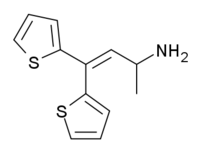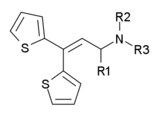Thiambutenes
 | |
| Clinical data | |
|---|---|
| ATC code |
|
| Identifiers | |
| |
| Chemical and physical data | |
| Formula | C12H13NS2 |
| Molar mass | 235.368 g/mol |
| 3D model (JSmol) | |
| Chirality | Racemic mixture |
| Melting point | 174 to 175 °C (345 to 347 °F) |
| |
| (verify) | |
The Thiambutenes are a family of opioid analgesic drugs developed at the British research laboratory of Burroughs-Wellcome in the late 1940s.[1] The parent compound thiambutene has no analgesic effects, but several compounds from this group are analgesics with around the same potency as morphine.
Notable compounds include dimethylthiambutene, diethylthiambutene, ethylmethylthiambutene, pyrrolidinylthiambutene and piperidylthiambutene. Of these, ethylmethylthiambutene is the most potent, with 1.3x the potency of morphine, pyrrolidinylthiambutene is the least potent at 0.7x, and the rest are all around the same potency as morphine.[2][3] Diethylthiambutene has been the most widely used, mainly in veterinary medicine.
All of these compounds produced anticholinergic and antihistamine side effects, except for two of the weaker compounds diallylthiambutene and morpholinylthiambutene. They also all have a chiral centre on the alpha carbon (where the R1 group is attached) and so have two stereoisomers, with the dextro isomer being the more potent in all cases, although both isomers are active.[4]
Three of these compounds are explicitly listed as illegal drugs under UN convention, diethylthiambutene, dimethylthiambutene and ethylmethylthiambutene, and so are illegal throughout the world, but the rest will only be illegal in countries such as the USA, Australia and New Zealand that have laws equivalent to the Federal Analog Act.

| Drug name | R1 | R2 | R3 | Analgesic Potency (Morphine = 1) |
|---|---|---|---|---|
| Ethylmethylthiambutene | methyl | ethyl | methyl | 1.3 |
| Dimethylthiambutene | methyl | methyl | methyl | 1.0 |
| Diethylthiambutene | methyl | ethyl | ethyl | 1.0 |
| Piperidylthiambutene | methyl | piperidyl | piperidyl | 1.0 |
| Pyrrolidinylthiambutene | methyl | pyrrolidinyl | pyrrolidinyl | 0.7 |
| Diallylthiambutene | methyl | allyl | allyl | 0.5 |
| Methylisopropylthiambutene | methyl | methyl | isopropyl | 0.5 |
| Morpholinylthiambutene | methyl | morpholinyl | morpholinyl | 0.5 |
| Methylpropylthiambutene | methyl | methyl | propyl | 0.1 |
| hydrogen | ethyl | ethyl | 0.2 | |
| hydrogen | pyrrolidinyl | pyrrolidinyl | 0.1 | |
| hydrogen | piperidyl | piperidyl | 0.1 | |
| phenyl | methyl | methyl | 0.1 | |
References
- ↑ US Patent 2561899 - Dithienyl Allyl Amines by Donald Wallace Adamson
- ↑ Adamson DW, Green AF. A new series of analgesics. Nature. 1950 Jan 21;165(4186):122. doi:10.1038/165122a0 PMID 15409854
- ↑ Adamson DW, Duffin WM, Green AF. Dithienylbutylamines as analgesics. Nature. 1951 Jan 27;167(4239):153-4. doi:10.1038/167153b0 PMID 14806409
- ↑ Green AF. Analgesic and other properties of 3: 3-dithienylalkenylamines. British Journal of Pharmacology and Chemotherapy. 1953 Mar;8(1):2-9. PMID 13066683